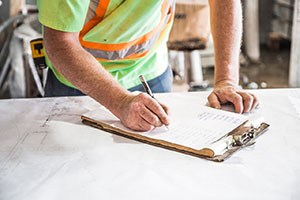What Does a Building Control Inspector See?

Whatever the build – a new build, extension, or a structural change – you will need building regulations approval. In this article woodworking machinery experts Daltons Wadkin will quickly take you through what to expect, look at some of the different types of inspections, and offer some advice. Firstly, it’s important to note the difference between planning approval and building regulations. Planning approval relates to receiving permission from the local authority to build an extension or new dwelling. Building regulations approval is a separate process, to ensure that the proposal will be built in full compliance. Once you’ve sorted which kind of approval you need, and before any work can begin, you need to decide whether to make a full plans building regulation application, or submit a building notice. With a building notice, it is possible for you to carry out the work without prior approval, but you need to be aware that the responsibility of ensuring the work is in full compliance, is entirely with the builder. If you choose a full plans application, then from the start you will know that the plan has been checked and approved by the building inspector, and that they fully comply with all of the building regulations. It’s important to note that the number and nature of the site inspections will vary according to the type of works being undertaken. Who Is Inspecting? Again, this varies with each type of build, but in most cases, you can choose to use either a local authority inspector from your local council and run through Local Authority Building Control (LABC), or an inspector from a government-approved private building inspection company. This is often the case for new builds, as well as alterations, extensions and loft conversions. You must check that the inspector is approved and registered with the Construction Industry Council. When a full plans application is made, a building inspector will check plans for compliance and carry out site inspections when requested, to check work on-site at various stages. Please bear in mind that only an inspector from your local authority has powers of enforcement, and an approved inspector must hand the project over to the local authority if there are problems with the project that cannot be resolved informally. To avoid any delays due to things being incorrect, it makes sense to keep on the right side of the inspector. They are there to help and are usually very willing to offer advice. Before starting any work, it’s a good idea to compare the approved building regulation plans with the original planning drawings one last time. Why not? It’s a quick job and can potentially save you any embarrassing mistakes. If the plans deviate in any way from the planning approved drawing, this needs to be addressed before any work starts. What Does a Building Control Inspector See? Well in short, lots! All projects – however big or small – will still be assessed in terms of the critical elements that need to be inspected, and again, each situation and build are different. Let’s use a domestic extension to give an example of possible inspection checks. Commencement:The first inspection will allow you to meet and discuss your proposals and subsequent course of action with your building control surveyor. This is particularly important for building notice applications where no plans have been submitted for approval. Foundations: They will look to check ground conditions to ensure that the foundations are sufficient to carry the load of your construction. This is before any foundations concrete is poured. Oversite Materials: Another inspection will be made to ensure materials and insulation over the site are suitable. Damp-Proof Courses and Membranes: All damp-proof courses, damp proof membranes, and methane barriers are to be inspected prior to covering with brickwork or concrete. Drainage Alignment:All new drainage needs to be inspected for alignment prior to covering over. This is to ensure the right access and fall is provided. Drain Test: Wherever possible, the new drainage systems should have a water test carried out on them, to check for performance and water tightness. Pre-Plasterboard: Allows for the inspection of hidden work and is to be carried out prior to plaster-boarding. This will also include any structural steelwork and the roof construction. Prior to Occupation: If there is an intention to occupy the building prior to completion of the full works, then there needs to be an inspection before occupation. Completion:Notification is required when the works are completed to allow this inspection to be carried out. If everything is found to be satisfactory, a completion certificate will be issued. Ideally, this inspection is carried out before the builder leaves the site. They may also look for the following: They may need to see the floor and ceiling joists to ensure they are in accordance with the approved drawing. They will want to check the size, grade and centres of the joists, together with any strutting and restraint strapping. All of the roof timber/trusses may be checked for correct size and grade of timbers at the correct spacing. They will be interested in both thermal and sound insulation to make sure it is of the correct type and thickness. The structural integrity of the building is very important, but equally the fire safety and glazing regulations need to be precisely adhered to. The staircase must conform to several important rules. If there are problems they can be expensive to put right. The approved plans do not always illustrate compliance to every regulation and on-site mistakes can happen. So, as you can see, there are lots of things to consider, and lots to get right! The Required Notification and Timings The building regulations require that notice is given to the local authority of commencement and completion of the work, and depending on the circumstance, at certain other stages too: Commencement: At least two days before the work is commenced Completion: Not more than five days after the work is completed In respect of other stages, the notice




